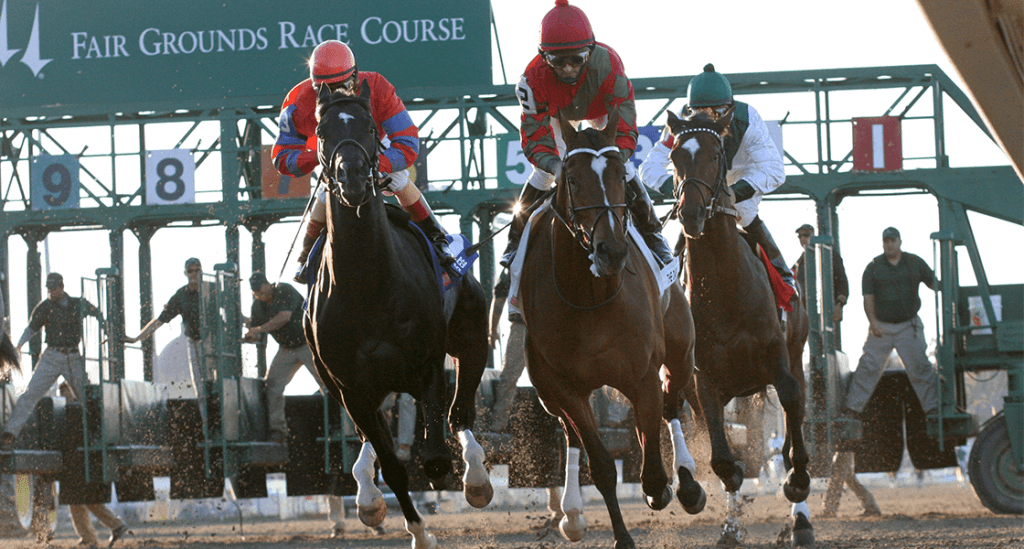
By Steve Zorn
The Fair Grounds winter meet in New Orleans kicks off on Thanksgiving Day, and this week the track announced a change in its wagering menu actually shows some concern for the bettor. In the light of recent takeout increases at many tracks and the profusion of “jackpot” bets that, as we will see, are actually a very bad idea, the Fair Grounds action is a welcome change.
For the last few years, Fair Grounds has offered a “Black Gold” Pick 5 in which only half the parimutuel pool was returned to winning bettors, unless there was a single winning ticket. If more than one picked all 5 winners, they shared half the after-takeout pool and the other half carried over into the jackpot. Only when there was a single unique winning ticket was the entire pool, including carryovers, paid out. Beginning this year, Fair Grounds will return to a “traditional” Pick 5, in which the entire pool, after takeout, is paid to winning bettors, whether there are one or 1,000 of them.
Initial takeout on the Pick 5 remains unchanged at 25%. That’s still too high, but that’s another story. But in the jackpot wager, if there was not just one winner on the day, then half of the post-takeout pool, or 37.5% of the total money bet, was also carried over, with only the remainder paid out to the multiple winners. That made the effective takeout on the bet, if you weren’t that lone winner, 62.5% (the initial 25% plus half of the 75% that remained). That actually made Fair Grounds’ Pick 5 one of the highest-takeout bets in North America. At Churchill Downs, in contrast, 90% of the post-takeout pool was paid out every day, and only 10% carried over, so the effective takeout was 23.5% (15% initial plus 10% of the remaining 85%).
And the average bettor wasn’t going to be a unique winner. Any Pick 5 sequence that produced a single winner would, of necessity, be one with a longshot or two. And the only tickets – if any – that would hit such a sequence would be massive “caveman” bets from deep-pocketed syndicates, usually betting online through dedicated ADWs. The only time it made any sort of financial sense for the typical horseplayer to bet the Pick 5 was on the very occasional force-out day, when the whole pool is paid to however many winning tickets have been played. Depending on the size of the carryover, betting on a force-out day could even be a positive-expectation bet, with the amount of the carryover plus the after-takeout pool for that day exceeding the amount bet on the day.
So, this year, Fair Grounds will return to paying out the whole pool, net of the 25% takeout, every day. Only if no one picks all 5 winners – a pretty rare occurrence in a five-race sequence – will there be a carryover. In that case, 25% of the after-takeout pool will be paid as a consolation payout, and the remaining 75% will carry over, but just to the next day.
There are still two problems with the Pick 5 bet. The 25% takeout is just too high, especially when many other tracks around the country – including Churchill Downs, owned by the same company that owns Fair Grounds – offer the same bet with a 15% takeout level. So, it’s not clear how much online action the bet will attract, other than from folks who consider Fair Grounds their home track. And the bet retains its 50-cent minimum. On the one hand, that seems like a good thing; you can bet a lot more combinations at 50 cents than if it were a $1 or $2 bet. But, on the other hand, that means lots of people bet lots more combinations, tending toward the “caveman” ticket that tries to win the wager by brute force, combining any plausible horse. And that leads to underlaid payouts and negates the benefits of careful handicapping, where one or two original insights into the race card can lead to a big payout.
Back in 2006, Steve Crist wrote “Exotic Betting,” for a long time the bible of those who played multi-race wagers. But that was before the era of jackpot bets, and before the profusion of 50-, 25- and even 10-cent bets that made it easier to win a bet without throwing too much money at it. Crist emphasized playing multiple tickets, trusting in your handicapping opinions and avoiding the inevitably underlaid all-favorites combinations. As bets have become cheaper, horseplayers – urged on by on-the-air handicappers – have been weaned away from this good advice in favor of just covering all the bases with a single big ticket. The result: more tickets are now underlays, and when you do hit a Pick 4 or Pick 5, the payoff won’t usually be enough to finance that kitchen renovation you wanted.
Measured in inflation-adjusted dollars, betting on horse races is steadily declining. And it’s declining even more when one looks just at the ordinary horseplayer; big online syndicates, betting through their own dedicated computer networks, have taken over an ever-larger share of the parimutuel market in the past decades. For the rest of us, our niche is relentlessly shrinking. A bet, like the 50-cent Pick 5, that rewards deep pockets instead of deep thoughts, won’t by itself help turn that situation around.
But kudos to Fair Grounds for at least making an effort.



